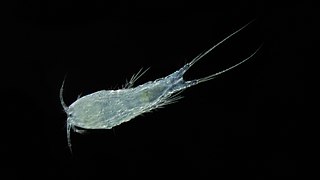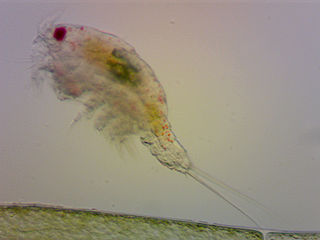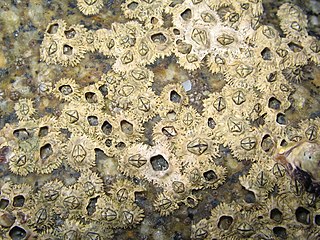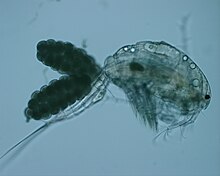
Aedes albopictus, from the mosquito (Culicidae) family, also known as (Asian) tiger mosquito or forest mosquito, is a mosquito native to the tropical and subtropical areas of Southeast Asia. In the past few decades, however, this species has spread to many countries through the transport of goods and international travel. It is characterized by the white bands on its legs and body.

Cyclops is one of the most common genera of freshwater copepods, comprising over 400 species. Together with other similar-sized non-copepod fresh-water crustaceans, especially cladocera, they are commonly called water fleas. The name Cyclops comes from the Cyclops of Greek mythology which shares the quality of having a single large eye, which may be either red or black in Cyclops.

Canthocamptus is a genus of copepods that live in water from the Arctic Ocean to the Atlantic Ocean. There are over 200 different species of Canthocamptus. A number of Australian endemic species are listed as vulnerable species on the IUCN Red List, and one Brazilian species is conservation dependent.
Acanthocyclops is a genus of copepod crustaceans in the family Cyclopidae. It was originally described by Friedrich Kiefer as a subgenus of Cyclops, and contains the following species:
Afrocyclops is a genus of copepod crustaceans in the family Cyclopidae, containing the following species:

Attheyella is a genus of copepods in the family Canthocamptidae, containing the following species:
Boeckella is a genus of copepods in the family Centropagidae.
Elaphoidella is a genus of freshwater copepods in the family Canthocamptidae. It contains over 200 species, including three classified as vulnerable species by the IUCN – three endemic to Slovenia and one endemic to the United States. In total, the genus Elaphoidella contains the following species:
Metacyclops is a genus of copepod crustaceans in the family Cyclopidae, containing 61 species, of which three are listed on the IUCN Red List – M. campestris from Brazil, M. gasparoi from Italy (vulnerable) and M. postojnae from Slovenia (vulnerable).
Notodiaptomus is a genus of copepods in the family Diaptomidae. It is the most widely distributed, most abundant and most species-rich genus of freshwater calanoid copepods in the Neotropics. The genus was erected in 1936 by Friedrich Kiefer for eleven species formerly placed in a wider Diaptomus. Notodiaptomus deitersi was chosen to be the type species by Raúl Adolfo Ringuelet in 1958.

Thermocyclops is a genus of crustacean in family Cyclopidae. It was first described and later extensively researched by Friedrich Kiefer, who discovered some 20 species. The species and subspecies of the genus inhabit fresh and brackish waters alike all around the world, although most are from tropical areas.
Tropocyclops is a genus of copepod crustaceans in the family Cyclopidae. It contains the following species:
Tropodiaptomus is a genus of copepods in the family Diaptomidae. It includes the following species, many of which are narrow endemics and are included on the IUCN Red List :

Diaptomidae is a family of freshwater pelagic copepods. It includes around 50 genera:

The Cyclopidae are a family of copepods containing more than half of the 1,200 species in the order Cyclopoida in over 70 genera.
Halicyclops is a genus of copepods belonging to the family Cyclopidae. There are currently 94 described species found in brackish habitats throughout the world:

The Hexanauplia constitute a class of crustaceans, comprising three groups: the Copepoda, the Tantulocarida and the Thecostraca.
Microcyclops is a genus of copepods, containing the following species:
Mesocyclops longisetus is a species of freshwater copepod in the family Cyclopidae. Two subspecies are accepted, Mesocyclops longisetus curvatus Dussart, 1987, and Mesocyclops longisetus longisetus. It has a neotropical distribution.








